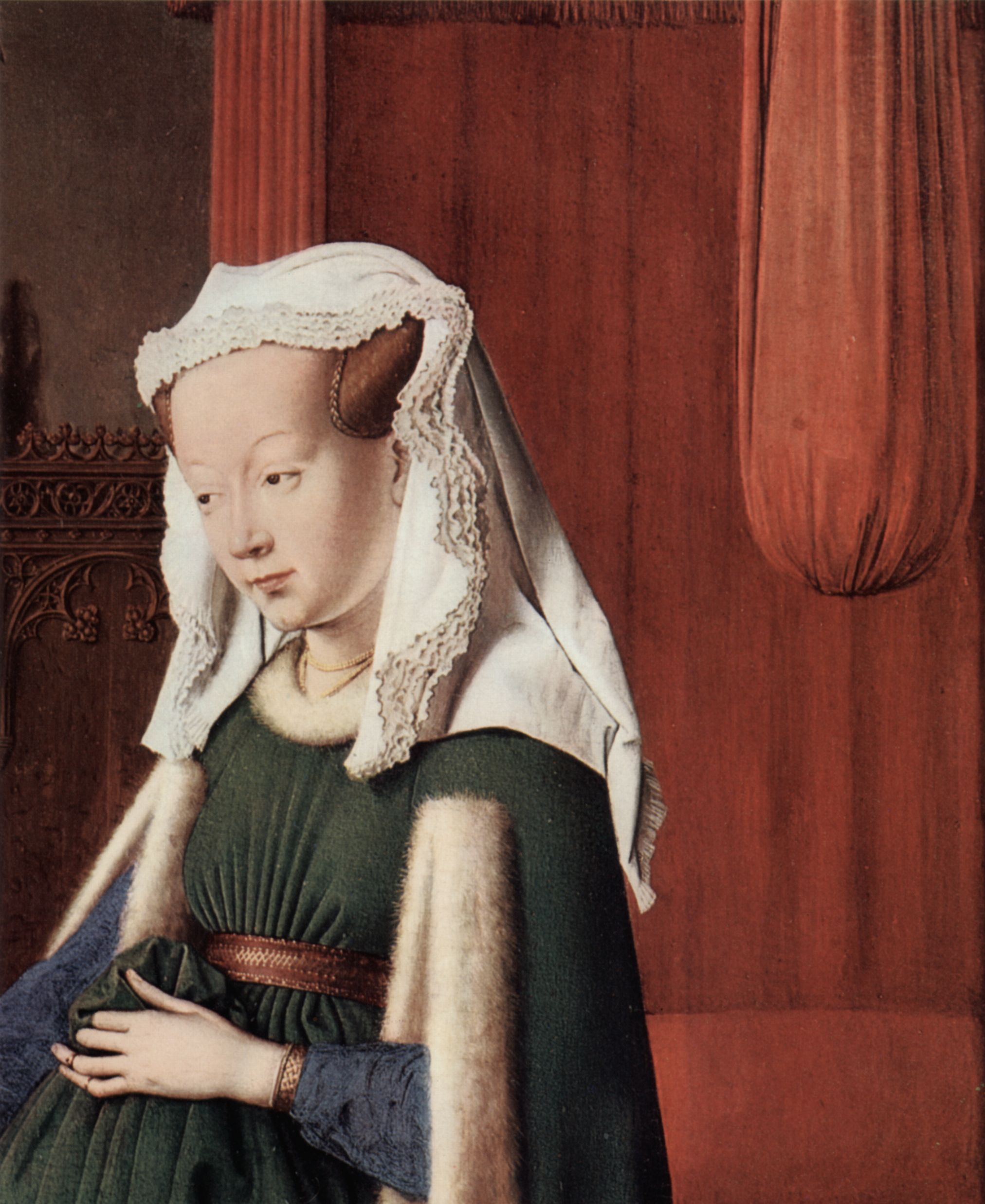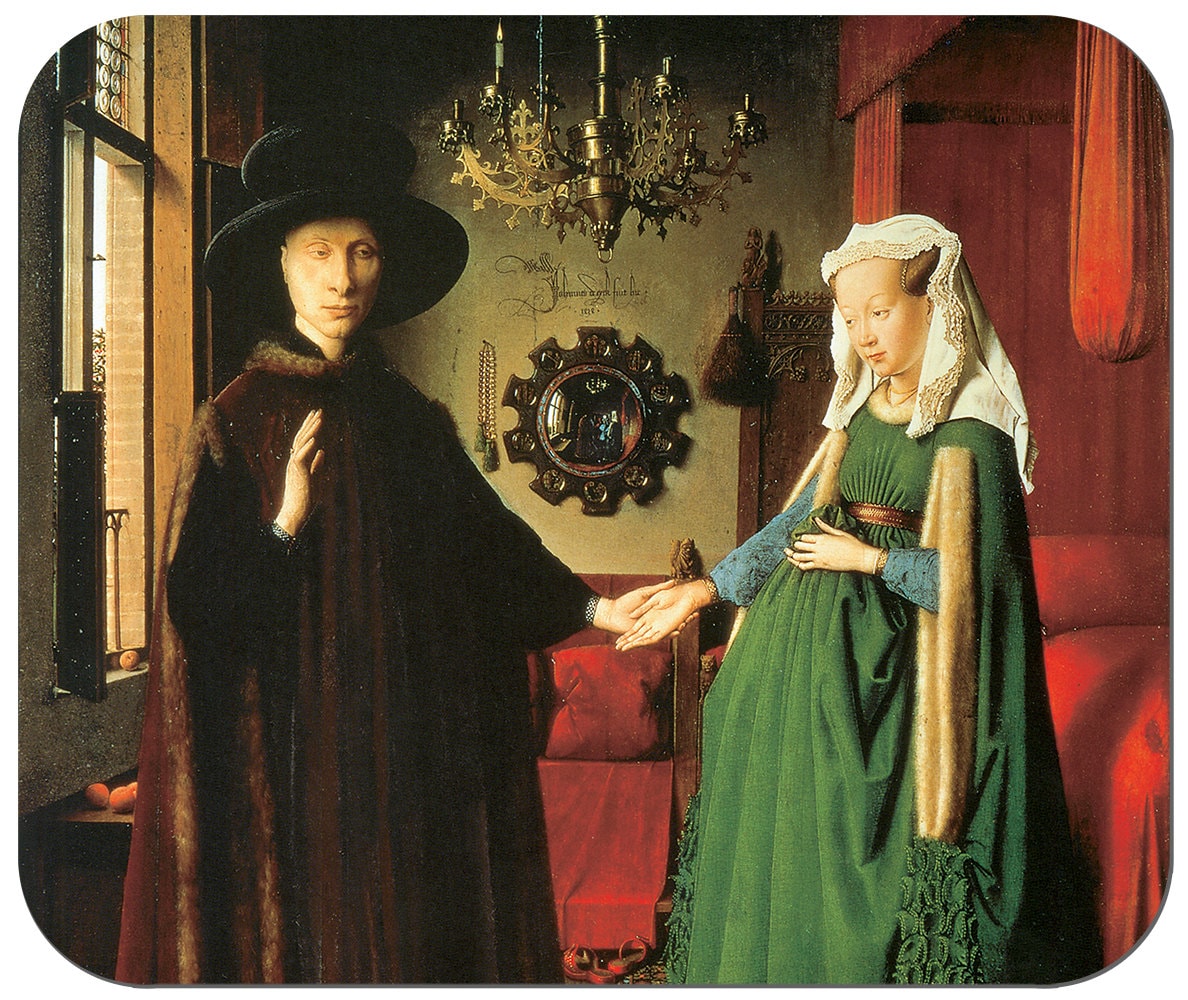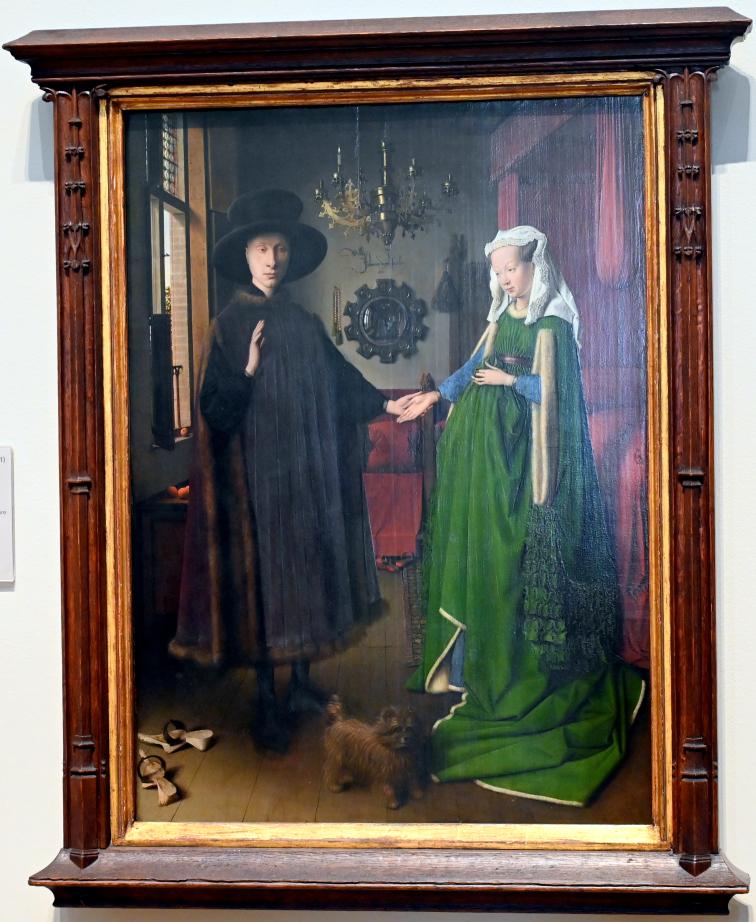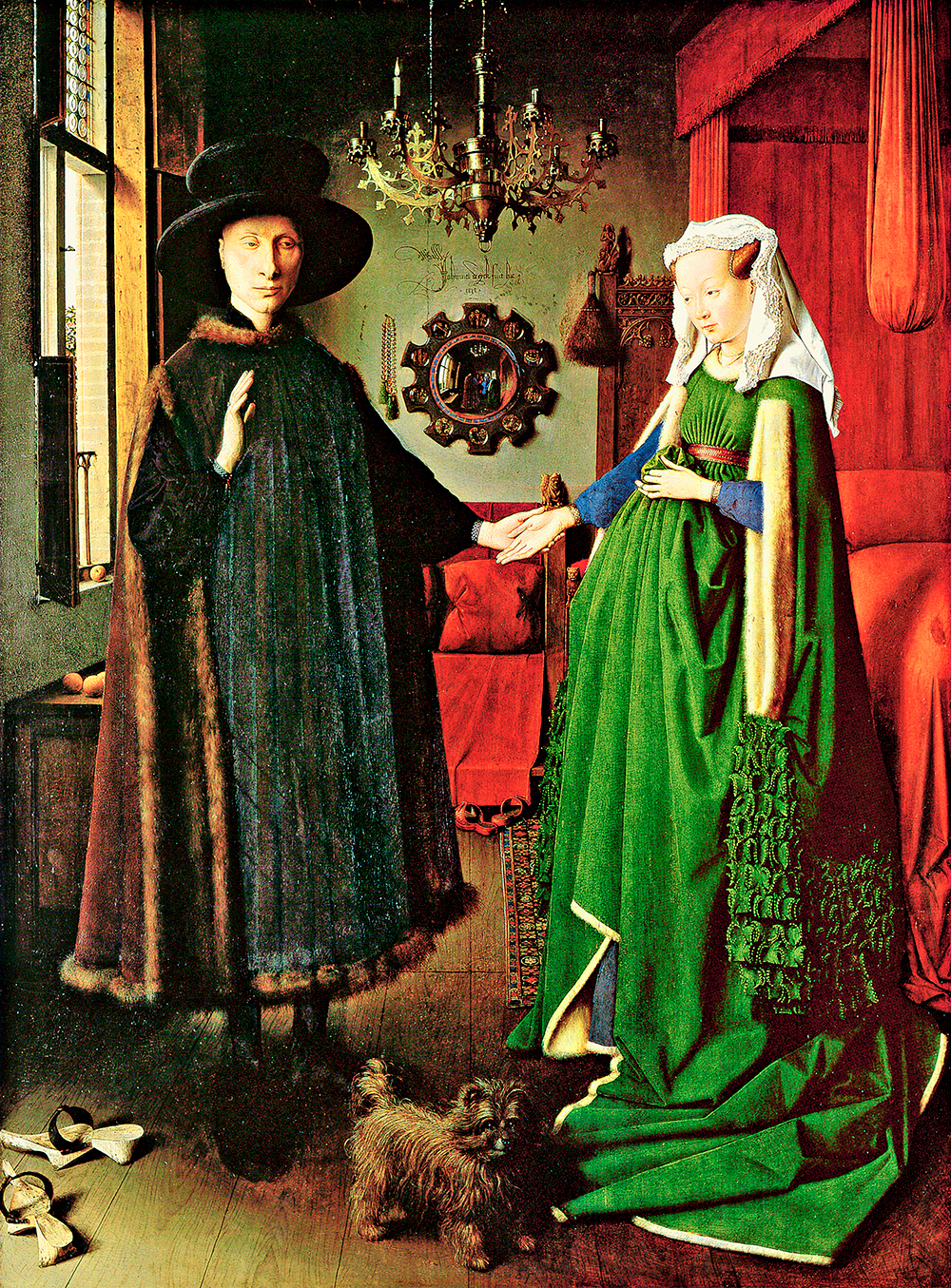
Jan van Eyck Die Arnolfini Hochzeit (1434) YouTube
The Arnolfini Portrait (or The Arnolfini Wedding, The Arnolfini Marriage, the Portrait of Giovanni Arnolfini and his Wife, or other titles) is a 1434 oil painting on oak panel by the Early Netherlandish painter Jan van Eyck.

Jan van Eyck (um 13901441), ArnolfiniHochzeit, Detail des Spiegels, 1434; Öl auf Holztafel, 82
Title: The Arnolfini Portrait Author: Jan van Eyck (Maaseik, Prince-Bishopric of Liège, Holy Roman Empire, Before 1390 or 1395 - Bruges, County of Flanders, Burgundian Netherlands, July 9, 1441 ) Date: 1434 Genre: Portrait art Movement: Northern Renaissance Technique: Oil painting Support: Oak Dimension: 82.2 cm x 60 cm (height x width) Location: The National Gallery, London

Großbild Jan van Eyck ArnolfiniHochzeit, Hochzeitsbild des Giovanni Arnolfini und seine Frau
This close look at van Eyck's jewel-like masterpiece of 1434 considers the intrigue and wonder it sparked when it first went on show at the National Gallery.

Großbild Jan van Eyck ArnolfiniHochzeit, Hochzeitsbild des Giovanni Arnolfini und seine Frau
This category has only the following subcategory. D Details of the Arnolfini Portrait (54 F) Media in category "The Arnolfini Portrait by Jan van Eyck" The following 26 files are in this category, out of 26 total. London National gallery Van Eyck Arnolfini Marriage 03.jpg 3,280 × 4,472; 4.39 MB

Arnolfini Hochzeit von Jan van Eyck Alles Wissenswerte
Jan van Eyck, The Arnolfini Portrait (1434). Oil on oak panel, 82.2 × 60 cm (32.4 × 23.6 in). National Gallery, London Items portrayed in this file. {Painting |Title= {{de|Arnolfini-Hochzeit, Hochzeitsbild des Giovanni Arnolfini und seiner Frau Giovanna Cenami}} {{en|Untitled, known in English as ''The Arnolfini Portrait'', ''The Arnolfini.

mp0090 Jan Van EYCK ArnolfiniHochzeit berühmte von Craftilocks
Jan van Eyck (born before 1395, Maaseik, Bishopric of Liège, Holy Roman Empire [now in Belgium]—died before July 9, 1441, Bruges) Netherlandish painter who perfected the newly developed technique of oil painting. His naturalistic panel paintings, mostly portraits and religious subjects, made extensive use of disguised religious symbols.

The Arnolfini Wedding Painting Jan Van Eyck 1434 Oil Paintings
I26. express an allegorical meaning, at the same time perfectly " fits " into a landscape or an interior apparently taken from life. In thiis respect the Arnolfini portrait is entirely. analogous to Jan van Eyck's religious paintings, such as the marvellous Virgin of Lucca where. many a symbol of virginity (the " aquae.

Jan van Eyck's The Arnolfini Wedding Portrait, left and color contrast... Download Scientific
National Gallery, London. Now, let's delve into the heart of the matter - The Arnolfini Portrait. Imagine the year 1434: Giovanni Arnolfini, a prosperous merchant, and his better half caught in an intimate moment. Van Eyck paints them with such meticulous detail that you can almost feel the texture of their garments and the warmth of the room.

Matrimonio Arnolfini La Cámara del Arte
Jan Van Eyck's Arnolfini Portrait sparks debate among art historians. The painting features an Italian merchant couple in 15th-century Bruges, showcasing their wealth and status. Theories suggest it could be a wedding, double portrait, or memorial. Van Eyck's mastery of oil paint and attention to detail make this artwork a Northern Renaissance.

EL MATRIMONIO ARNOLFINI ENSEÑARTE
Jan van Eyck was born in the small town of Maaseyck, then known as Eyck, near a bend of the river Maas about 14 miles from Maastricht, the provincial capital of modern-day Limburg. The history of the region can be traced back to the Roman Empire era, and later grew into a religious center during the early medieval period.

Porträt des Giovanni Arnolfini und seiner Frau ("ArnolfiniHochzeit"), Jan van Eyck, 1434
The Arnolfini Portrait (1434) by Jan van Eyck; Jan van Eyck, Public domain, via Wikimedia Commons. A formal analysis will discuss what is occurring in the painting and its stylistic details, taking a closer look at Jan van Eyck's techniques and how he composed the art piece with reference to the elements of art.

Jan Van Eyck, El matrimonio Arnolfini (1434)
The Arnolfini Portrait Jan van Eyck Unable to open [object Object]: HTTP 403 attempting to load TileSource Insights Van Eyck's Arnolfini Portrait View time: 4:00 This close look at van Eyck's jewel-like masterpiece of 1434 considers the intrigue and wonder it sparked when it first went on show at the National Gallery in 1843.

Jan Van Eyck Die Arnolfini Hochzeit Germany Hochzeit
The Arnolfini Portrait (1434) by Jan van Eyck, framed and on display at the National Gallery in London; Jan van Eyck, CC BY 3.0, via Wikimedia Commons. Rosary beads are also hung beside the mirror. In paintings, oranges depict fertility, and so does the red bed. St. Margaret is depicted on the finial, and the cherry tree just outside of the screen is a sign of love.

Großbild Jan van Eyck ArnolfiniHochzeit, Hochzeitsbild des Giovanni Arnolfini und seine Frau
Born in what is now Belgium, artist Jan van Eyck (c. 1390-1441) was an early master of the oil medium and used it to create meticulously detailed compositions. His most prominent work, The Arnolfini Portrait, remains an icon of the Northern Renaissance—encapsulating many of the aesthetic ideals and technical innovations of the time period.
 1434 (detail of 1765) - (MeisterDrucke-60506).jpg)
Das Porträt von Giovanni Arnolfini und seine Frau Giovanna Cenami (Die ArnolfiniHochzeit) 1434
Das unter dem Namen Arnolfini-Hochzeit bekannte Doppelporträt des flämischen Malers Jan van Eyck entstand 1434. Das signierte und datierte Tafelbild zeigt möglicherweise ein Mitglied der im 15. Jahrhundert in Brügge tätigen Kaufmannsfamilie Arnolfini und seine Gattin oder, so eine andere Annahme, Jan und Margarete van Eyck.

Posterlounge Wandbild Jan van Eyck »Arnolfini Hochzeit« online kaufen OTTO
The Arnolfini Portrait is one of the most recognizable paintings from the Northern Renaissance. Attached to this 15th-century piece of art are multiple theories, interpretations, and analyses of two Flemish people painted by the artist Jan van Eyck.